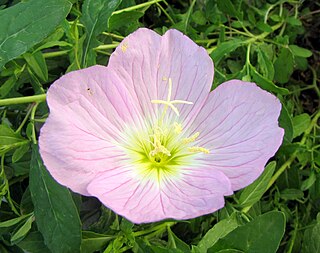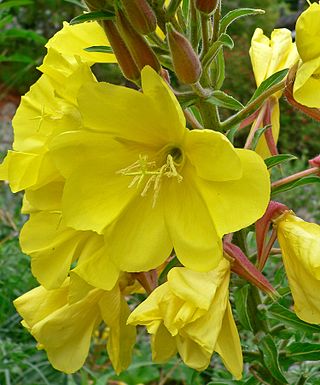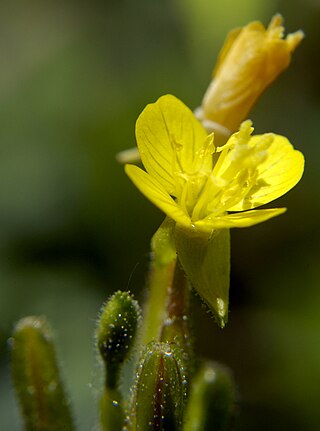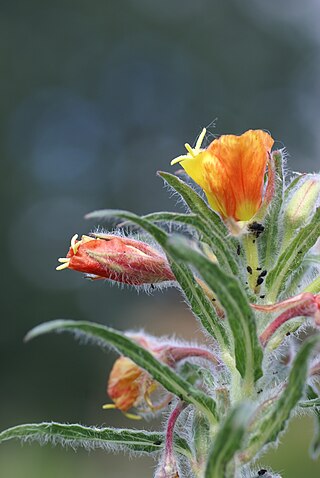
Oenothera is a genus of about 145 species of herbaceous flowering plants native to the Americas. It is the type genus of the family Onagraceae. Common names include evening primrose, suncups, and sundrops. They are not closely related to the true primroses.

Epilobium is a genus of flowering plants in the family Onagraceae, containing about 197 species. The genus has a worldwide distribution. It is most prevalent in the subarctic, temperate and subantarctic regions, whereas in the subtropics and tropics Epilobium species are restricted to the cool montane biomes, such as the New Guinea Highlands.

Oenothera speciosa is a species in the Oenothera family known by several common names, including pinkladies, pink evening primrose, showy evening primrose, Mexican primrose, amapola, and buttercups.

Oenothera biennis, the common evening-primrose, is a species of flowering plant in the family Onagraceae, native to eastern and central North America, from Newfoundland west to Alberta, southeast to Florida, and southwest to Texas, and widely naturalized elsewhere in temperate and subtropical regions. Evening primrose oil is produced from the plant.

Camissonia, sometimes commonly known as sun cup or sundrop, is a genus of annual and perennial plants in the evening primrose family Onagraceae. A total of 12 species are known, nearly all from western North America, especially in the California Floristic Province, but also one from South America. Previous circumscriptions of the genus had recognized up to 62 species before it was split among other closely related genera.

Kalmia angustifolia is a flowering shrub in the family Ericaceae, commonly known as sheep laurel. It is distributed in eastern North America from Ontario and Quebec south to Virginia. It grows commonly in dry habitats in the boreal forest, and may become dominant over large areas after fire or logging. Like many plant species of infertile habitats it has evergreen leaves and mycorrhizal associations with fungi. It is also found in drier area of peat bogs.

Oenothera elata is a species of Oenothera known by the common name Hooker's evening primrose or tall evening primrose. Subspecies include hookeri, hirsutissima, longisima, jamesii, villosa and elata. It is native to much of western and central North America. The plants are quite tall, especially the hookeri subspecies, native to California, which can reach about 1.8 meters height. The plants are found along roadsides, in moist meadows, or woodland, from sea level up to 9,000 ft (2,700 m) in elevation.

Oenothera perennis is a species of flowering plant in the family Onagraceae and is native to the eastern United States and Canada. Its common names include little evening primrose, small sundrops, and small evening primrose. Its native habitats include shaly slopes, moist or dry fields, pastures and roadsides. Oenothera perennis is a perennial herb. It has yellow flowers that open during the day and close at night. Each flower has four petals that are notched at the tip with veins radiating from the base.

Oenothera glazioviana is a species of flowering plant in the evening primrose family known by the common names large-flowered evening-primrose and redsepal evening primrose. Oenothera lamarckiana was formerly believed to be a different species, but is now regarded as a synonym of Oe. glazioviana.

Oenothera macrocarpa, the bigfruit evening primrose, Ozark sundrops, Missouri evening primrose, or Missouri primrose, is a species of flowering plant in the evening primrose family Onagraceae, native to northeast Mexico and the south-central United States, where it is found in calcareous prairies and limestone outcrops.

Calylophus serrulatus is a species of flowering plant in the Onagraceae known by the common name yellow sundrops. Other common names include halfshrub sundrop, serrate-leaved evening primrose, shrubby evening primrose, plains yellow primrose, and halfleaf sundrop. It is native to central North America, including central Canada and the central United States.

Oenothera berlandieri, commonly called Berlandier's sundrops, is a species of flowering plant in the evening primrose family (Onagraceae). It is native to North America, where it is found primarily in the south central region of the United States and in northern Mexico. Its natural habitat is dry prairies, often in rocky or sandy calcareous areas.

Oenothera versicolor, the red evening-primrose, is a species of flowering plant in the family Onagraceae, native to South America, from Peru and Ecuador down to Bolivia and Northern Argentina This species is not as common in cultivation as other members of the genus but popular cultivars including 'Sunset Boulevard' are grown in gardens around the temperate world as the plant is hardy down to at least −10 °C (14 °F).

Oenothera tetragona, the glaucous evening primrose, is a species of flowering plant in the family Onagraceae, native to eastern North America, and introduced to Germany, the Czech Republic, and Myanmar. The Royal Horticultural Society considers it a good plant to attract pollinators. There is a cultivar, 'Glaber', also known as 'Clarence Elliott'.
















